|
- LRP Flow Worksteam Speed Control And X20 Motor -
Test Bench TRIED • TESTED • TORTURED
Worlds-winning Pro Power System
By Peter Vieira
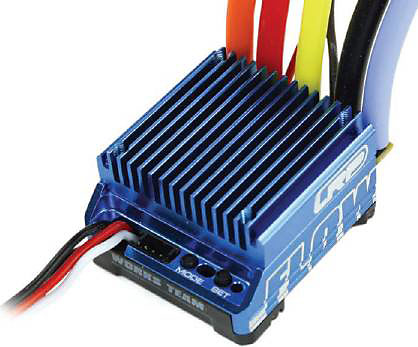 As its name implies, LRP’s Flow WorksTeam speed control is the blue crew’s top-of-the line racing speed control, as used by LRP’s team drivers. That includes Steven Hartson, who used it in his Associated B44.2 to win the 2013 IFMAR Off-Road Electric 4WD Worlds, and Ronald Volker, who just won the prestigious 2014 Reedy Touring Car Race and recently sealed his fourth consecutive European Touring Car Series title. The Flow models include the WorksTeam for stock and modified classes and the slightly lower priced Flow Competition, which is perfect for stock racing because of its 9.5 turn motor limit. A machined aluminum case, included cooling fan, and an improved commutation algorithm keep temps in check, and naturally, the speed control offers a full range of tuning adjustments including variable timing. I tested the Flow WorksTeam in combination with LRP’s X20 modified motor for the full LRP professional-grade brushless power experience.
As its name implies, LRP’s Flow WorksTeam speed control is the blue crew’s top-of-the line racing speed control, as used by LRP’s team drivers. That includes Steven Hartson, who used it in his Associated B44.2 to win the 2013 IFMAR Off-Road Electric 4WD Worlds, and Ronald Volker, who just won the prestigious 2014 Reedy Touring Car Race and recently sealed his fourth consecutive European Touring Car Series title. The Flow models include the WorksTeam for stock and modified classes and the slightly lower priced Flow Competition, which is perfect for stock racing because of its 9.5 turn motor limit. A machined aluminum case, included cooling fan, and an improved commutation algorithm keep temps in check, and naturally, the speed control offers a full range of tuning adjustments including variable timing. I tested the Flow WorksTeam in combination with LRP’s X20 modified motor for the full LRP professional-grade brushless power experience.

The Flow WorksTeam helped Steven Hartson score the IFMAR Worlds 4WD cup, which can hold a ton of M&Ms.
FEATURES
It would require more space than we have here to cover all of the Flow WorksTeam’s features, but here are a few standouts that merit a closer look. For a complete list of the Flow’s adjustable settings, see the Specs.
Torque, Boost and Turbo timing: Dynamic timing advance is not a new idea in speed controls, but LRP goes one step further with the concept by offering three different types of timing change. Boost Timing works like the dynamic timing advance you may already be familiar with. Without physically altering the motor’s sensor configuration, the speed control applies 5 - 50° of timing advance (as set by you) across the full rpm range. Torque timing actually reduces the amount of torque you feel making the low end smoother, which is helpful when you’ve got more torque than traction — and the X20 motors definitely have a lot of torque. Turbo Timing advances timing beyond the Boost setting, adding another 5, 7, or 10° of timing at full throttle.
Adjustable Boost Trigger and Boost Angle: In case it hasn’t already hit you, you can really fine-tune timing with the Flow. The boost trigger setting is the rpm at which the electronic timing advance engages, and boost angle refers to timing in degrees per 1,000rpm. For example, if you set the Flow for 30° of timing advance (boost), set boost timing for 7,600rpm, and set boost angle for 0.6°, that means the motor will advance timing 0.6° for every 1,000rpm over 7,600. The higher the boost angle, the more aggressive the “boost.”
Boost 0 Racing: “Boost zero” is LRP parlance for “blinky mode.” When the Flow’s dynamic timing (“boost”) systems are switched off, the speed control’s blue LED will flash continuously to indicate there is no timing change when the throttle is applied. This makes it easy to confirm you’re not cheating in a stock class or any other “no timing allowed” race situation.
Transmitterless setup changes: you do not need to switch on your transmitter when making setup changes, just power up the Flow and do your thing. If you’re using a non-2.4GHz radio, you’ll just need to unplug the speed control from the receiver. But seriously, it’s 2014. Get a 2.4GHz transmitter already.
Fading Compensation: LRP has devised a unique algorithm to compensate for falling voltage as the battery is depleted, so driving feel does not change (or the change is less apparent, at least).
X-Brake Pro: LRP promises “sharper response and super-linear feeling,” or as you may choose to call it, “crazy strong brakes.” The manual suggests you set up the transmitter to max out at 80% of max braking force. This is good advice.
INSTALLATION AND SETUP
The Flow speed control and X20 motor install like any other motor, but do pay attention to the speed control’s orientation in the chassis. The sensor harness plugs in beneath the solder posts, and will be difficult to access if the back of the speed control is against a chassis rib or the side of the battery tray. The Flow arrives with power wires soldered in place, and the wire lengths are ample for any 1/10 scale car, including mid-motor 2WD buggies. Connector choice is left to you if you prefer to use plugs, and hard-wiring the Flow to the X20 motor’s pre-tinned solder tabs was easy thanks to the scalloped tab shape. I installed the motor using the factory setting for static timing. LRP’s static-timing system is unique. Instead of rotating the entire endbell, the endbell is fixed and only the “PreciSensor” sensor assembly rotates. A plastic insert that surrounds the sensor harness plug sets the sensor’s position at 27.5, 30, 32.5, 35, or 37.5°, with the 27.5° insert installed at the factory.
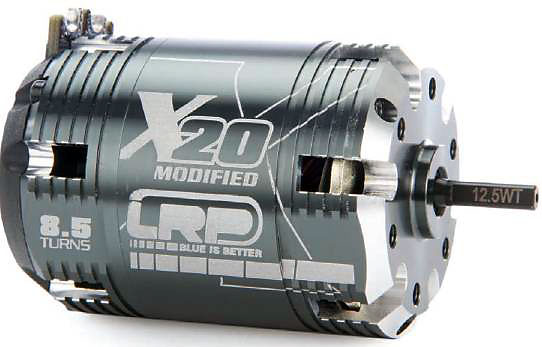
Radio setup is very quick; all you have to do is press the SET button to confirm the trigger’s neutral, full-throttle, and full-brake positions. Tinkering with the other settings (drag brake, minimum drive, etc.) requires a little more focus; you use the MODE button to cycle through the settings, noting the LED colors to see what mode number you’re on, and press the SET button to cycle through the values for each mode. Not hard, but an external programming card or PC interface system would be welcome.
With the default settings, the Flow cranks up power smoothly, precisely, and seemingly effortlessly — it’s eerily good. The factory minimum drive setting of 7% throttle delivers a punchy but tractable feel that can easily be cranked higher for lower-power motors or dialed down for even more precise low-throttle control, which is helpful with a hot motor such as the 7.5-turn modified I installed (the 8.5-turn motor shown in photos is from our March issue’s X20 motor review). I bumped drag brake from zero to 6% to suit my preference, and turned maximum brake down to about 70% at the transmitter. The Flow has a lot of braking force, with excellent modulation. If you run on high-traction tracks that favor hard, late braking, you’ll like the precise braking feel. Slow is fast for me, so my experimentation with the boost setting was purely in the name of a thorough review — I don’t need more straightaway speed! Unlike some speed controls I’ve driven that seem to “shift gears” when timing advance kicks in, the Flow retained its smooth feel with lower “boost angle” settings. As the manual explained, higher values gave a more aggressive “kick in” feel. With zero boost, my Associated T4.2 Factory Team topped out at 40.1mph. With the maximum boost setting of 50°, that speed jumped to 46.5mph. Yep, it works.
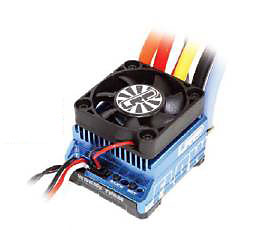
The Flow WorlsTeam includes an optional plug-in fan.
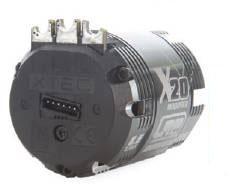
Note the rectangular insert around the sensor port. Four additional inserts are included to alter the angle of the PreciSensor and set static timing.
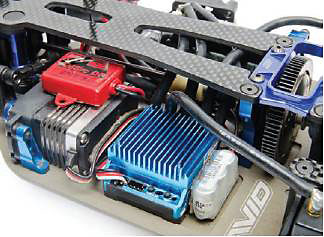
Above: Here’s the Flow WorksTeam in Steven Hartson’s B44.2 Factory Team. Note the optional WorksTeam capacitor.
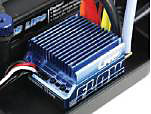
Right: I installed the Flow in an Associated T4.2 for testing.
Specs
LRP FLOW WORKS TEAM
Item no.: 80970 (Flow WorksTeam speed control only); 81143 (Flow WorksTeam with X20 7.5 motor)
Price: $190; $270
Input voltage: 3.7-7.4V
Motor limit (7.4V): 3-turn
Case size: 32 x 34 x 21mm
Case material: Aluminum
Voltage drop (@ 20amp per phase): 0.011V
Rated current per phase: 400A
Cooling fan: Included BEC volts/amps: 6V/3A
Power wires: 12 gauge Weight (without wires): 40g
Overload protection: Thermal (motor and speed control)
Locked rotor Low-voltage cutoff: Yes, adjustable (3.2, 4.0, 6.4V)
ADJUSTABLE FEATURES
• Drag brake: 0-40%
• Minimum drive: 3-12%
• Torque timing: 5-25°, off
• Boost timing: 5-50°, off
• Boost angle & activation (degress:1000rpm): 0.2-4.5
• Turbo timing: 5, 7, 10°, off
LRP X20 7.5T MODIFIED MOTOR
Item no.: 50664
Price: $95
Input voltage: 3.7-7.4V
RPM (7.4V): 34,040
RPM per volt (KV): 4,600
Power (Watts) (7.4V): 357
Weight: 165g
Rotor: Balanced WorksTeam, sintered, 12.5mm
Winding: Star pattern, copper multistrand
Rules compliance: IFMAR, EFRA, ROAR, FEMCA, JMRCA, BRCA, DMC
World’s Fastest Firmware
There was once a time when having the latest software in your speed control required you to go out and buy the latest speed control. With the LRP Flow, SXX, iX8, and Spin speed controls, you can update the firmware via your computer, assuring you always have the latest and high-performance code straight from the factory. Along with access to a PC or Mac and the required software download (free, of course), you’ll need LRP’s no. 81801 USB Bridge Spec.2 Firmware Update Link (not free, $35). The updater connects to the speed control the sensor wire port and plugs into the computer via USB port. Then all you have to do is follow the prompts on the screen to connect the speed control with the software, select the firmware file, and update the speed control. The latest updates for the LRP Flow are V4.7 for on-road, used by Ronald Volker in his on-road victories, and V3.8 for off-road, which is the same firmware Steven Hartson used to win the 2013 IFMAR Electric Off-Road Worlds’ 4WD class championship. I uploaded the new V3.8 code for this review and the process was simple and fast.

The optional Bridge Spec.2 Firmware Update Link lets you connect the Flow WorksTeam to your computer and download the latest firmware via a simple online interface.
THE VERDICT
Is anyone really going to be surprised that a $270 power system with Worlds-winning cred turns out to be a top performer? Probably not — I certainly wasn’t surprised, given my previous experience with LRP gear and the inarguable success LRP has had on the track its many National and World titles. The Flow WorksTeam and X20 motor ooze quality and project a “serious racing equipment” vibe because they are indeed high quality and are serious racing gear. The price matches the performance, but the LRP gear is priced in line with competitive systems from other brands, so it’s hard to complain there. And, you get what you pay for. In this case, you’re paying for a speed control and motor that can win World Championships.
Plus
+ Pro-quality gear proven in battle—see Steven Hart-son’s Worlds win
+ Highly tuneable timing advance system
+ Simple, precise static-timing adjustment
+ Solid aluminum speed control case
+ Updateable firmware
Minus
- Not cheap (no surprise there)
- LRP doesn’t offer a programming card or computer interface for setting changes
Source:

|
